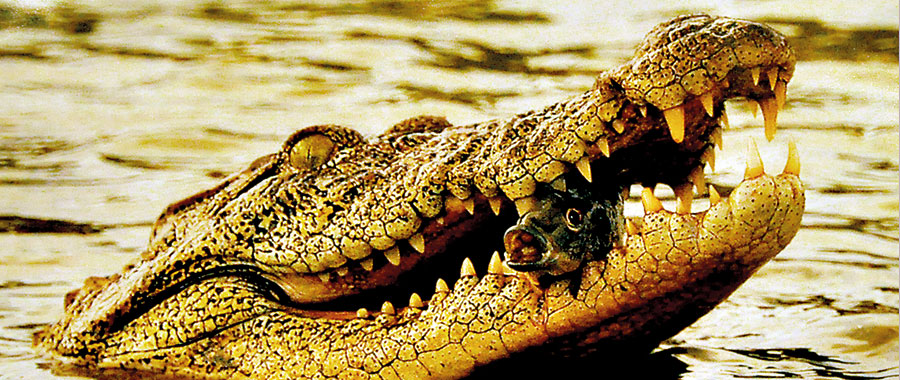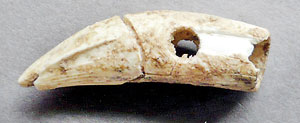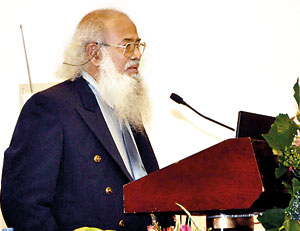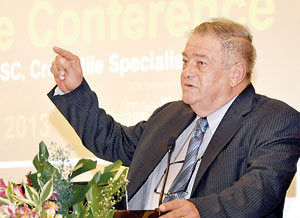Giving teeth to crocodile connection from the past
View(s):Kumudini Hettiarachchi reports on the World Crocodile Conference held in Sri Lanka
It was a unique find and the obvious question that follows is still hidden in the dim mists of time. The layers of earth just inside the northern entrance to the 4th century AD Jethavanaramaya at Anuradhapura which unearthed their bounty during excavations by the Central Cultural Fund (CCF) in the 1980s leaves open the question: Why?

Jaws: In this photograph of Ranjith de Silva exhibited at the conference, a fish has just become prey
The bounty came in the form of 50 teeth of different kinds of animals including crocodiles. They were not just teeth, but drilled or perforated teeth which gave a clear signal that they had been used as ornaments.
A presentation on this “find” at the World Crocodile Conference held this week in Negombo kept the attention of the delegates riveted.
Were these perforated or drilled crocodile teeth offered as part of a religious ritual, asks Kelum Manamendra-Arachchi of the Post-graduate Institute of Archaeology, University of Kelaniya, who was called in by the CCF in 2010 for the “exciting” task of identifying the teeth.
Among the 50 perforated teeth uncovered in excavations at Jethavana are also those of dog, mongoose, civet and fishing cats, leopard, porcupine and bear, says Mr. Manamendra-Arachchi when contacted by the Sunday Times, adding that the delicate method by which these holes have been made suggests not only the skill but also the high standard of technology used.
Contrasting the Jethavana perforated teeth with ornaments found elsewhere in the country, Mr. Manamendra-Arachchi says that evidence of ‘Balangoda Manawaya’ or Stone Age Man (from 38,000 to 3,800 Before Present) has been recorded at Batadomba lena at Kuruwita; Pahiyangala at Bulathsinhala; Beli lena at Kitulgala and Pothgul lena at Alawala, Gampaha. Excavations found a huge amount of faunal material which Balangoda Man had used as their food. However, they had made ornaments only of shark-teeth and shells and shell-fragments, with no record of teeth of mammals and crocodiles found on land.
In Europe, according to him, excavations had found perforated animal teeth but that from the Neolithic Period as opposed to the Historical Period of the Jethavana finds. The European Neolithic teeth which include those of reindeer had been part of burial and not religious (like at Jethavana) rituals.

A perforated croc tooth. Pic by Kelum Manamendra Arachchi
Picking out the perforated teeth found at Jethavana, Mr. Manamendra-Arachchi says that the drilled teeth artefacts belonged to eight vertebrates including 10 of a marsh crocodile or Crocodylus palustris.
“These may have been used as a necklace, arguably worn by a hunter,” the paper written by Mr. Manamendra-Arachchi, Thusitha Mendis of the Department of Archaeology and Heritage Management, Rajarata University, and Anslem de Silva states. Another possibility is that the hunter who had killed these animals may have made a vow and placed these hunting trophies on the offering altar to the Lord Buddha, pledging never to hunt again, they add.
Several other interesting papers on different aspects of the crocodile situation in Sri Lanka (see boxes) were presented at this 22nd Working Meeting of the Crocodile Specialist Group (CSG) of the International Union for the Conservation of Nature (IUCN)/Species Survival Commission (SSC). Crocodile expert Anslem de Silva was the Conference Director and current Regional Chairman of CSG for South Asia and Iran.
All about muggers
Gravid muggers go variable distances from water to lay (oviposit) their eggs, but first dig a guard burrow (hole) and stay there to ward off predators, the ‘Preliminary observations on the selection of nesting sites of Crocodylus palustris’ by Anslem de Silva, G.W.R.P. Rathnasiri of the Department of Wildlife Conservation and Adrian R. Gabriel state.

Conference Director and current Regional Chairman of CSG for South Asia and Iran, Anslem de Silva at the opening ceremony on May 21. Pix by Indika Handuwala
During their ongoing island-wide survey of crocodiles, they had observed 31 mugger nests – three with unhatched eggs, 17 in mugger borrows and the rest hatched. While they had saved one nest with 17 fully-formed embryos that villagers were about to destroy and later seen them hatch, they had also observed a burrow with hatchlings and their parents.
If the mugger is unable to find a suitable location for the guard burrow, it would dig a hole 30cmX30cm and deposit the eggs, they said, adding that a few nests were spotted along busy roadsides and human habitation.
Meanwhile, these three researchers in this first detailed island-wide study had observed about 200 mugger burrows at 26 separate locations, belonging to two types – the ‘shelter’ used in the hot dry season when the crocodile’s aquatic habitat is drying or dried and the mugger virtually aestivates in the low temperature inside the chamber and the ‘guard’ or ‘defence’ one which is dug to stay close to the nest and protect it from predators.
Human-croc conflict
Crocs attacked when humans were either bathing or washing, an island-wide survey of the human-crocodile conflict (HCC) carried out by Anslem de Silva from 2009 to March 2013 has found.
Of the people who fell victim to the mugger (Crocodylus palustris) and the salt-water crocodile (C. porosus),148 were men and 26 women, Mr. de Silva who visited the locations of the attacks, took photographs and documented the victims’ wounds and scars has found. Forty-nine people died in the attacks.

CSG Chairman Prof. Graham Webb delivering the keynote address.
Presenting his findings on ‘Crocodile attacks in Sri Lanka’, he points out that 113 attacks occurred when the victims were bathing or washing, 38 when they were fishing and the balance when they were engaged in other activity at the water’s edge.
Explaining that his study indicates negligence on the part of humans and also under-estimation of the crocodile’s intelligence, Mr. de Silva is quick to point out that Crocodile Excluding Enclosures proved to be effective against such attacks.
Crocs in Wilpattu
Recommending annual studies to ascertain crocodile numbers in the Wilpattu National Park (WNP) with its unique water bodies, Adrian R. Gabriel in his paper, ‘The status of the mugger (Crocodylus palustris) inhabiting the WNP’ also suggests that their possible inter-villu and villu to river migrations in the dry season should also be verified.
In the preliminary survey of 27 villus during the day and 14 villus in the night conducted in August 2011, the paper explains that the day-count revealed 27 crocodiles and the night count using the eye-shine technique found 50.
In the “first recorded” mugger-nest sighting reported from WNP, Mr. Gabriel says that it was found on September 7, 2011, with 13 egg-shells scattered, nine hatchlings and a guard burrow in Kokmutai by the Modaragam Aru.
Follow @timesonlinelk
comments powered by Disqus


